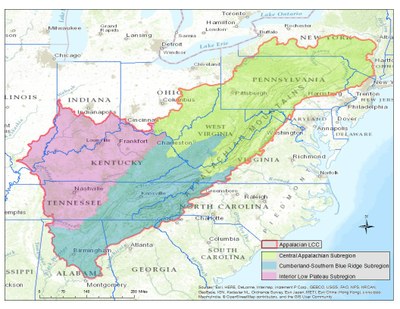Assessing Vulnerability of Species and Habitats to Large-scale Impacts: CCVA
 The Appalachian region is rich in biodiversity that is highly threatened by energy production, development, and a host of other factors. Large-scale impacts such as climate change will play out within this context, affecting habitats and species in different ways. Understanding the vulnerability of various species and habitats within the Appalachian LCC to such changes is of critical importance. Identifying the steps needed to acquire vulnerability information and then using this information to inform adaptation and mitigation strategies is a major research priority of the LCC.
The Appalachian region is rich in biodiversity that is highly threatened by energy production, development, and a host of other factors. Large-scale impacts such as climate change will play out within this context, affecting habitats and species in different ways. Understanding the vulnerability of various species and habitats within the Appalachian LCC to such changes is of critical importance. Identifying the steps needed to acquire vulnerability information and then using this information to inform adaptation and mitigation strategies is a major research priority of the LCC.
The Appalachian LCC provided a grant to NatureServe to conduct critical vulnerability assessments. Researchers first convened a panel of experts to compile and review existing vulnerability assessments, compare strengths and weaknesses of methodologies used, and recommend a vulnerability assessment method for adoption. The recommended method was then deployed to generate vulnerability assessments for a suite of key species and habitats selected in consultation with partners of the Cooperative. The completed assessments are now on the Web Portal, where users can view and search by vulnerability scores, conservation status ranks, state and subregion of assessment, and higher taxonomy.
In the presentations below, Dr. Lesley Sneddon of NatureServe gives an in-depth overview of this research. The bulk of the presentations provide viewers with step by step instructions on how to access, utilize, and interpret the many vulnerability assessments for species and habitats - both previous assessments that were assembled by the research team and new assessments that were developed for this project.
|
PHASE 1In 2012, the LCC tasked NatureServe with a two-phase project that provided the LCC with: guidance on the most appropriate climate change vulnerability approaches; compilation of the existing assessments, of which there are many; and conducting new assessments where they're needed.
|
|
The first order of business was to assemble a panel of experts to provide guidance on selecting the approaches, identifying the appropriate climate data, and providing criteria to help select species and habitats that need to be assessed. |
|
The panel convened a two-day working session at NatureServe's Arlington office to discuss this and document their findings and the recommendations. You can find the result of their work in the PDF document titled Understanding Land Use and Climate Change in the Appalachian Landscape: Phase I. The following Videos will walk you through the Assessing Vulnerability of Species and Habitats to Large-scale Impacts Toolkit
PHASE 2 |


























